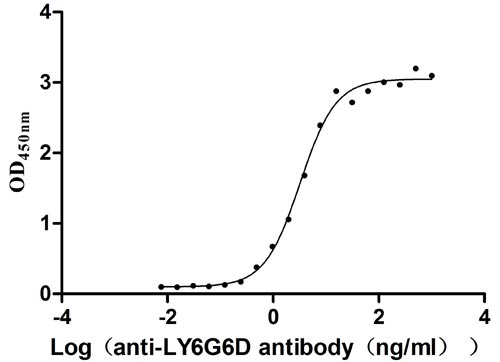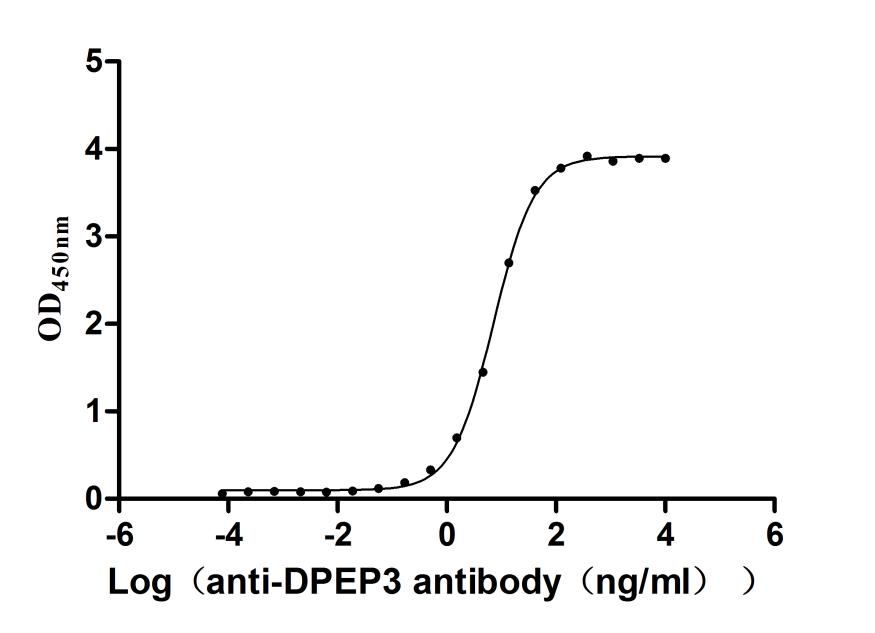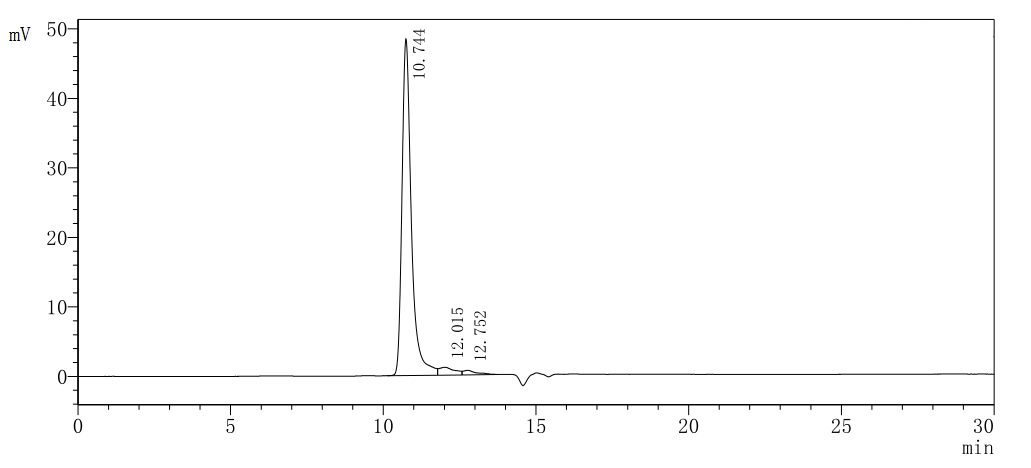Recombinant Mouse Mitogen-activated protein kinase 3 (Mapk3)
-
货号:CSB-YP013456MO
-
规格:
-
来源:Yeast
-
其他:
-
货号:CSB-EP013456MO
-
规格:
-
来源:E.coli
-
其他:
-
货号:CSB-EP013456MO-B
-
规格:
-
来源:E.coli
-
共轭:Avi-tag Biotinylated
E. coli biotin ligase (BirA) is highly specific in covalently attaching biotin to the 15 amino acid AviTag peptide. This recombinant protein was biotinylated in vivo by AviTag-BirA technology, which method is BriA catalyzes amide linkage between the biotin and the specific lysine of the AviTag.
-
其他:
-
货号:CSB-BP013456MO
-
规格:
-
来源:Baculovirus
-
其他:
-
货号:CSB-MP013456MO
-
规格:
-
来源:Mammalian cell
-
其他:
产品详情
-
纯度:>85% (SDS-PAGE)
-
基因名:
-
Uniprot No.:
-
别名:Mapk3; Erk1; Prkm3; Mitogen-activated protein kinase 3; MAP kinase 3; MAPK 3; EC 2.7.11.24; ERT2; Extracellular signal-regulated kinase 1; ERK-1; Insulin-stimulated MAP2 kinase; MAP kinase isoform p44; p44-MAPK; MNK1; Microtubule-associated protein 2 kinase; p44-ERK1
-
种属:Mus musculus (Mouse)
-
蛋白长度:Full Length of Mature Protein
-
表达区域:2-380
-
氨基酸序列AAAAAAPGG GGGEPRGTAG VVPVVPGEVE VVKGQPFDVG PRYTQLQYIG EGAYGMVSSA YDHVRKTRVA IKKISPFEHQ TYCQRTLREI QILLRFRHEN VIGIRDILRA PTLEAMRDVY IVQDLMETDL YKLLKSQQLS NDHICYFLYQ ILRGLKYIHS ANVLHRDLKP SNLLINTTCD LKICDFGLAR IADPEHDHTG FLTEYVATRW YRAPEIMLNS KGYTKSIDIW SVGCILAEML SNRPIFPGKH YLDQLNHILG ILGSPSQEDL NCIINMKARN YLQSLPSKTK VAWAKLFPKS DSKALDLLDR MLTFNPNKRI TVEEALAHPY LEQYYDPTDE PVAEEPFTFD MELDDLPKER LKELIFQETA RFQPGAPEGP
-
蛋白标签:Tag type will be determined during the manufacturing process.
The tag type will be determined during production process. If you have specified tag type, please tell us and we will develop the specified tag preferentially. -
产品提供形式:Lyophilized powder
Note: We will preferentially ship the format that we have in stock, however, if you have any special requirement for the format, please remark your requirement when placing the order, we will prepare according to your demand. -
复溶:We recommend that this vial be briefly centrifuged prior to opening to bring the contents to the bottom. Please reconstitute protein in deionized sterile water to a concentration of 0.1-1.0 mg/mL.We recommend to add 5-50% of glycerol (final concentration) and aliquot for long-term storage at -20℃/-80℃. Our default final concentration of glycerol is 50%. Customers could use it as reference.
-
储存条件:Store at -20°C/-80°C upon receipt, aliquoting is necessary for mutiple use. Avoid repeated freeze-thaw cycles.
-
保质期:The shelf life is related to many factors, storage state, buffer ingredients, storage temperature and the stability of the protein itself.
Generally, the shelf life of liquid form is 6 months at -20°C/-80°C. The shelf life of lyophilized form is 12 months at -20°C/-80°C. -
货期:Delivery time may differ from different purchasing way or location, please kindly consult your local distributors for specific delivery time.Note: All of our proteins are default shipped with normal blue ice packs, if you request to ship with dry ice, please communicate with us in advance and extra fees will be charged.
-
注意事项:Repeated freezing and thawing is not recommended. Store working aliquots at 4°C for up to one week.
-
Datasheet :Please contact us to get it.
靶点详情
-
功能:Serine/threonine kinase which acts as an essential component of the MAP kinase signal transduction pathway. MAPK1/ERK2 and MAPK3/ERK1 are the 2 MAPKs which play an important role in the MAPK/ERK cascade. They participate also in a signaling cascade initiated by activated KIT and KITLG/SCF. Depending on the cellular context, the MAPK/ERK cascade mediates diverse biological functions such as cell growth, adhesion, survival and differentiation through the regulation of transcription, translation, cytoskeletal rearrangements. The MAPK/ERK cascade plays also a role in initiation and regulation of meiosis, mitosis, and postmitotic functions in differentiated cells by phosphorylating a number of transcription factors. About 160 substrates have already been discovered for ERKs. Many of these substrates are localized in the nucleus, and seem to participate in the regulation of transcription upon stimulation. However, other substrates are found in the cytosol as well as in other cellular organelles, and those are responsible for processes such as translation, mitosis and apoptosis. Moreover, the MAPK/ERK cascade is also involved in the regulation of the endosomal dynamics, including lysosome processing and endosome cycling through the perinuclear recycling compartment (PNRC); as well as in the fragmentation of the Golgi apparatus during mitosis. The substrates include transcription factors (such as ATF2, BCL6, ELK1, ERF, FOS, HSF4 or SPZ1), cytoskeletal elements (such as CANX, CTTN, GJA1, MAP2, MAPT, PXN, SORBS3 or STMN1), regulators of apoptosis (such as BAD, BTG2, CASP9, DAPK1, IER3, MCL1 or PPARG), regulators of translation (such as EIF4EBP1) and a variety of other signaling-related molecules (like ARHGEF2, FRS2 or GRB10). Protein kinases (such as RAF1, RPS6KA1/RSK1, RPS6KA3/RSK2, RPS6KA2/RSK3, RPS6KA6/RSK4, SYK, MKNK1/MNK1, MKNK2/MNK2, RPS6KA5/MSK1, RPS6KA4/MSK2, MAPKAPK3 or MAPKAPK5) and phosphatases (such as DUSP1, DUSP4, DUSP6 or DUSP16) are other substrates which enable the propagation the MAPK/ERK signal to additional cytosolic and nuclear targets, thereby extending the specificity of the cascade.
-
基因功能参考文献:
- Low ERK1 Phosphorylation is associated with low liver regeneration. PMID: 30142376
- A. fumigatus increased PAR-2 expression and elevated disease, PMN infiltration, and proinflammatory cytokine expreERK1 Kinasession through PAR-2, which may be modified by p-ERK1/2. PMID: 29332129
- ERK1 and ERK2 play specific roles in beta cells. ERK2 cannot always compensate for the lack of ERK1 but the absence of a clear-cut phenotype in Erk1 (-/-) mice shows that ERK1 is dispensable in normal conditions. PMID: 28721437
- The Macrophage Activation Induced by Bacillus thuringiensis Cry1Ac Protoxin Involves ERK1/2 and p38 Pathways and the Interaction with Cell-Surface-HSP70. PMID: 28608568
- hBD-1 potentiates the induction of in vitro osteoclastogenesis by RANKL via enhanced phosphorylation of the p44/42 MAPKs. PMID: 28709835
- ERK1 role in the osteoclast differentiation.Insulin induces RANK expression via ERK1/2, which contributes to the enhancement of osteoclast differentiation. PMID: 28535663
- ERK1 underexpression is associated with obesity. PMID: 28302472
- We also demonstrated that ERK1 deletion potentiates DC vaccination and provides a survival advantage in high-grade gliomas. PMID: 27256374
- Consistent with the essential role of ERK1/2 during macrophage differentiation and defects of macrophagic differentiation in native ERK1(-/-) progenitors, ERK signaling is strongly activated in Eger/Fms cells upon M-CSF-induced macrophage differentiation. PMID: 26336156
- T1R1/T1R3 have roles in regulating ERK1/2 and mTORC1 in MIN6 cells PMID: 26168033
- ERK/GSK3beta signaling was involved in the apoptotic and G1 phase arrest effects of AT-I in melanoma cells. PMID: 26151480
- RET coupling to ERK and Akt depends strongly on artemin concentration, and it is highest at the low (~100 pM) artemin levels required for neurite outgrowth. PMID: 25635057
- ablates negative regulation by AMPK and contributes to FcepsilonRI-mediated activation of the mast cells PMID: 24948367
- our data implicate MNK1 as a key component of BDNF-mediated translational regulation in neurons. PMID: 25609615
- The rapidly changing ERK1 phosphorylation was visualized in the intestinal epithelial stem cells of mouse small intestine. PMID: 23793953
- Data indicate that caspase-8 activity is lost upon deletion of c-FLIPL, and p43FLIP rescues caspase-8 activity through Raf1, TRAF2, and RIPK1 association, augmenting ERK and NF-kappaB pathways. PMID: 24275659
- The observed activation ERK1/2 and GFAP, both markers of Muller cell gliosis, in the absence of Muller cell proliferation, is consistent with the activation of atypical gliosis occurring during the slow process of degeneration in Rpe65(-/-) mice. PMID: 24012986
- The findings of this study suggested a model where ERK1/2 MAP kinase signaling acts as a myelin thickness rheostat that instructs oligodendrocytes to generate axon-appropriate quantities of myelin. PMID: 24259565
- As the retina matures, ERK1 is activated and plays a role in retinal degeneration. PMID: 20950336
- desipramine-increased HO-1 expression is mediated by Nrf2 activation through the ERK and JNK signaling pathways PMID: 23209658
- Data indicate that thiazolidinediones (TZDs) rapidly activated Erk1/2 and p38 through G protein-coupled receptor 40 (GPR40), a receptor expressed on the surface of osteocytes. PMID: 22593579
- Development of bladder hyperalgesia was associated with robust enhancement of ERK1/2 activation in the dorsal horn and deeper laminae bilaterally in the L6-S1 spinal cord. PMID: 21705143
- IL-4 may protect mice against BCG/LPS-induced immune liver injury, with ERK and NF-kappaB signal pathways involved in the effects PMID: 21947361
- MAPK phosphorylation is a useful marker to study short-term neural activation associated with the expression of specific behaviors. PMID: 21451356
- Data demonstrate Erk1 plays an important role in osteoclast functions. PMID: 21961044
- ERK1/2 was stimulated in neurons cultured from mucopolysaccharidosis type IIIB mice. ERK1/2 was significantly higher in the cortex of 1-2-month-old affected animals compared with wild-type littermates. PMID: 21618584
- For the first time, activation of ERK 1/2 in the spinal cord reveals the time-wise development of an estrogen-dependent chronic hyperalgesic state. PMID: 20971161
- An aberrant ERK1/2 signaling mechanism influences various neuronal functions and plays a significant role in cognitive dysfunction of ribosomal s6 kinase (rsk)2 deficient mice. PMID: 21838783
- dopamine D1 receptor agonists cause Erk-dependent increases in Zif268 and Arc/Arg3.1 expression in mouse dentate gyrus PMID: 21559295
- identify ERK1 as an important regulator of PrP(c) cellular homeostasis and indicate that this kinase exerts a dual control of PrP(c) levels through transcriptional and post-transcriptional mechanisms. PMID: 21586567
- Gene expression analysis showed a significant regulation of extracellular signal-regulated kinases (ERK)1, ERK2 and c-Jun N-terminal kinase (JNK)3 genes in JEV infected neuroblastoma cells. PMID: 21320173
- Data show that inhibition of MEK broadly affects the cellular network in a multipathway manner. PMID: 21427409
- Results demonstrate that the targeting of ERK1 could partially protect obese mice against insulin resistance and liver steatosis by decreasing adipose tissue inflammation and by increasing muscle glucose uptake. PMID: 20953578
- ROS generation by J774A.1-MacCM is required for Akt and ERK1/2 signaling to promote 3T3-L1 preadipocyte survival. PMID: 21056559
- Results indicate that activated MAPK3 (& MAPK1) promotes cell proliferation and differentiation in the initial segment of the developing epididymis; in the adult, the role if MAPK3 (& MAPK1) switches to maintaining cell survival. PMID: 20650883
- Data show that deletion of Erk1/2 in Schwann cell precursors caused disrupted differentiation and marked hypomyelination of axons. PMID: 21220101
- AMPK-mediated PLD1 activation is required for (14)C-glucose uptake through ERK stimulation PMID: 20231899
- Hypersensitivity to the ERK1/2 pathway activation leads to excessive protein synthesis in the hippocampus of a model of fragile X syndrome. PMID: 21084617
- Data suggest that ERK1 phosphorylation is indispensable for the GD1a signal suppressing NOS2. PMID: 20589721
- intracellular RHAMM(Delta163) functions as an adaptor protein to control microtubule polymerization during interphase and mitosis as a result of localizing ERK1/2-MEK1 complexes to their tubulin-associated substrates PMID: 20558733
- the Gemini vitamin D analog BXL0124 inhibits the growth of ErbB2 overexpressing mammary tumors through regulating the ErbB2/AKT/ERK signaling pathways PMID: 20304052
- These results conclude that ERK1 plays a limited role in nociceptive sensitization in an animal model of pain. PMID: 20739576
- p62 is a crucial regulator of ERK1 in metabolism PMID: 20154642
- MAPK3 is a negative regulator of dendritic cells. MAPK3 is dispensable for growth & development, but it plays an essential role in DC that then maintain a moderate T-cell response during autoimmune reactions. PMID: 20186879
- Loss of ERK1 results in an enhanced splenic erythropoiesis. PMID: 20223923
- ERK nuclear translocation is dimerization-independent but controlled by the rate of phosphorylation PMID: 19920141
- a preformed signaling complex mediates GnRH-activated ERK phosphorylation of paxillin and FAK at focal adhesions in L beta T2 gonadotrope cells PMID: 19628583
- In the superficial laminae of the dorsal horn of the spinal cord there was an increase in expression of Erk-1 following surgery under remifentanil anesthesia. PMID: 19917879
- Thus we demonstrate a GR-dependent ERK-mediated pathway that modulates auditory function after RS and acoustic trauma. PMID: 19413500
- Based on a MEK1-derived peptide, we developed inhibitors of ERK activation in vitro and in vivo. PMID: 11756441
显示更多
收起更多
-
亚细胞定位:Cytoplasm. Nucleus. Membrane, caveola. Cell junction, focal adhesion.
-
蛋白家族:Protein kinase superfamily, CMGC Ser/Thr protein kinase family, MAP kinase subfamily
-
数据库链接:
KEGG: mmu:26417
STRING: 10090.ENSMUSP00000051619
UniGene: Mm.8385
Most popular with customers
-
Recombinant Human Tumor necrosis factor ligand superfamily member 18 (TNFSF18), partial (Active)
Express system: Mammalian cell
Species: Homo sapiens (Human)
-
Recombinant Human C5a anaphylatoxin chemotactic receptor 1 (C5AR1)-VLPs (Active)
Express system: Mammalian cell
Species: Homo sapiens (Human)
-
Express system: Mammalian cell
Species: Homo sapiens (Human)
-
Recombinant Human Lymphocyte antigen 6 complex locus protein G6d (LY6G6D) (Active)
Express system: Yeast
Species: Homo sapiens (Human)
-
Recombinant Human Serine/threonine-protein kinase receptor R3 (ACVRL1), partial (Active)
Express system: Baculovirus
Species: Homo sapiens (Human)
-
Recombinant Human Dipeptidase 3(DPEP3), partial (Active)
Express system: Mammalian cell
Species: Homo sapiens (Human)
-
Express system: Mammalian cell
Species: Homo sapiens (Human)
-
Recombinant DT3C (Diphtheria toxin & spg 3C domain) for Antibody Internalization Assay
Express system: E.coli
Species: Corynephage beta




















